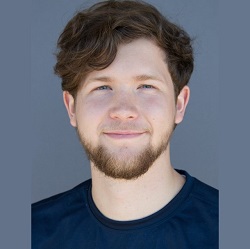Prebiotic amino acids bind to and stabilize prebiotic fatty acid membranes

Members of the Keller Research Group, including UW Astrobiology grad student Zachary Cohen (Chemistry), and his advisor (Sarah Keller, Chemistry), discovered what may be a key mechanism in the origin of life, and published their findings in the Proceedings of the National Academy of Sciences earlier this year. Zach and Sarah are also helping us work towards bringing the Chemistry department on as a new campus partner for the Dual-Title Astrobiology PhD program.
How did the first cells on Earth arise? In a minimal cell, a membrane separates proteins and RNA from the surrounding aqueous environment. Cell-like membranes spontaneously assemble from simple prebiotic surfactants called fatty acids. However, fatty acid membranes are unstable in solutions containing salts that were likely present in environments of the early Earth.
The Keller Group found that amino acids, the building blocks of proteins, bind to fatty acid membranes and stabilize them against salts. Moreover, enhanced stabilization persists after dilution as would occur when a dehydrated pool refills with water—a likely setting for the emergence of cells. In addition to explaining how the first membranes were stabilized, their findings answer how key components of the first cells colocalized.

Discussing the relevance of this work to the field of Astrobiology UWAB Student and co-author on the paper, Zack Cohen, said “Understanding the origin of cells on Earth is a critical aim in astrobiology. This research is a step towards a more general chemical understanding of the transition from non-life to life. This knowledge is critical if we hope to constrain the possibilities for life elsewhere in the universe.”
You can read their full article here.
This work has also received a significant amount of press coverage, including:
- Ed Yong for The Atlantic “The Origin of Life May Not Be as Coincidental as Scientists Once Thought“, Aug. 12, 2019.
- Sofie Bates for Inside Science “The Origin of Life May Not Be as Coincidental as Scientists Once Thought“, Aug. 12, 2019.
- NASA Research Highlight “Did Amino Acids Stabilize Prebiotic Membranes?”, Aug. 14, 2019.
- Hank Green – SciShow News “How Cells Got Their Membranes (Maybe)“, Aug. 16, 2019.
- Sunny Wang for the UW Daily “The bond behind origins of life: Amino acids bind to and stabilize membranes in salty environments, provides predictions about life on other planets“, Nov. 4, 2019
- Charles Mudede for The Stranger “My Brother’s Passing, God, and the Origins of Life“, Sep. 11, 2019
Here are some other science updates and highlights from the rest of our team members this past year:

Postdoctoral Researcher Kim Bott, Prof. Victoria Meadows (Astronomy), and VPL team member Jeremy Bailey’s paper on WASP 18b’s polarization was accepted to the Astronomical Journal!
You can read the pre-print of the aricle on on arXiv.

UWAB Alum Rodrigo Luger (Astronomy, 2018) has a paper now in press in the Astronomical Journal, titled: “STARRY: Analytic Occultation Light Curves.”

Postdoctoral Researcher Shintaro Kadoya (ESS) recently had a paper published in the Astrophysical Journal, titled: “Outer Limits of the Habitable Zones in Terms of Climate Mode and Climate Evolution of Earth-like Planets.”

UWAB Alum Steven Sholes’ (ESS, 2019) paper “A Maximum Subsurface Biomass on Mars from Untapped Free Energy: CO and H2 as Potential Antibiosignatures” was accepted in Astrobiology!
You can read the pre-print of the article on arXiv.
Steven’s Mars paleoshoreline paper was also finally accepted to the Journal of Geophysical Research: Planets and is now available online!

Postdoctoral Researcher Michael Wong (Astronomy) is a co-author on a paper that came out in Astrobiology titled “Methane on Mars and Habitability: Challenges and Responses,” which is based on a pair of workshops that were recently held at Caltech.
Mike was also invited to give a lecture at the Rose City Astronomers September 2019 General Meeting to talk specifically about astrobiology.

Prof. Eric Agol (Astronomy) had a couple of papers published reviewing discoveries with the Kepler spacecraft which you can read here.
Prof. Agol also had a paper accepted to the Astronomical Journal on differentiable transiting planet models, which will be useful for transit-tranmission spectroscopy.

Grad Student Diana Windemuth’s (Astronomy) paper on “An Automated Method to Detect Transiting Circumbinary Planets” has been accepted for publication at the Monthly Notices of the Royal Astronomical Society!

UWAB Alum Matt Koehler and Prof. Roger Buick (ESS) had a paper published reporting unfractionated nitrogen isotopes recording nitrogen fixation by Mo-nitrogenase in anoxic deep waters at 2.95 billion years ago.

UWAB Alum Eddie Schwieterman (Astronomy, 2016) had a paper published in the Astrophysical Journal on estimating plausible carbon monoxide levels on inhabited exoplanets with implication for remote detectability.
Or a feature on the work on Space.com

Grad Student Eliah Overbey (Genome Sciences) recently published two papers!
and

Grad Student Hector Delgado Diaz’s (Astronomy) paper with Renyu Hu, titled “Stability of Nitrogen in Planetary Atmospheres in Contact with Liquid Water”, was recently published on ArXiv!

Grad Student Owen Lehmer’s (ESS) paper on micrometeorite oxidation as a proxy for CO2 in the Archean was accepted by Science Advances! The paper is a result of Owen’s research rotation project with Prof. Don Brownlee.

Grad Student Zac Cooper (Oceanography) had his first paper recently published in the Federation of European Microbiological Societies. The Paper is titled: “Distinctive microbial communities in subzero hypersaline brines from Arctic coastal sea ice and rarely sampled cryopegs.”

Grad Student Andrew Lincowski (Astronomy) had a recent papers published in the Astronomical Journal, titled: “Observing Isotopologue Bands in Terrestrial Exoplanet Atmospheres with the James Webb Space Telescope: Implications for Identifying Past Atmospheric and Ocean Loss.”

Profs. Jonathan Toner and David Catling (ESS) recently published a paper about the origin of titled: “Alkaline lake settings for concentrated prebiotic cyanide and the origin of life.”

UWAB Alum Brett Morris (Astronomy, 2019) has a new accepted paper in the Monthly Notices of the Royal Astronomical Society, titled: “The Solar Benchmark: Rotational Modulation of the Sun Reconstructed from Archival Sunspot Records.”
